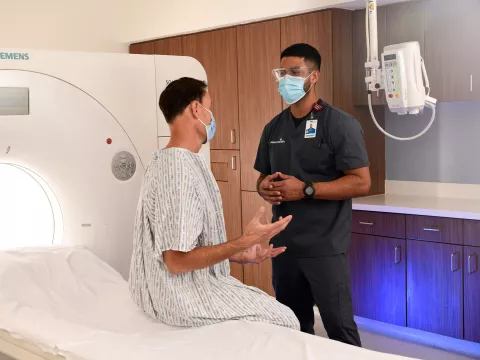- AdventHealth

Choose the health content that’s right for you, and get it delivered right in your inbox.
A positron emission tomography scan, or PET scan, is an effective way to help identify a variety of conditions, including (and not limited to) cancer, heart disease and brain disorders. Your health care provider can use this data to help diagnose, monitor and treat your condition.
We’re here to explain how PET scans work, why they’re done, how to prepare for your scan and what to expect, along with how your provider interprets the results.
How Does a PET Scan Work?
A PET scan uses a radioactive drug called a tracer to show both normal and abnormal metabolic activity. This scan can often detect the abnormal metabolism of the tracer in diseases before they show up on other imaging tests, such as a computed tomography (CT) or magnetic resonance imaging (MRI) scan.
The tracer is most often injected into a vein in your hand or arm. The tracer will collect into areas of your body that have higher levels of metabolic or biochemical activity, which can pinpoint the location of the disease. The images from the PET scan are usually combined with those from the CT and/or MRI.
How to Prepare for a PET Scan
- Before the day of your PET scan, be sure to reach out to your doctor if:
- You've ever had a bad allergic reaction
- You've been sick recently, or you have another medical condition, such as diabetes
- You're taking any medications, vitamins or herbal supplements
- You're pregnant, or you think you might be pregnant
- You're breastfeeding
- You're afraid of enclosed spaces (claustrophobic)
Your doctor will give you detailed instructions on how to prepare for your scan. A general rule is to avoid strenuous exercise for a couple of days before the study and to fast for four hours before the scan.
What to Expect at Your PET Scan
Generally speaking, you can prepare for and expect the following at your PET scan:
- You’ll be asked to remove any clothing, jewelry or other objects that could interfere with the scan
- If asked to remove clothing, you will be given a gown to wear
- You will empty your bladder before beginning the scan
- One or two IV lines will be inserted into your hand or arm
- Some types of abdominal or pelvic scans may require that a urinary catheter be inserted into your bladder
- An initial scan may be performed before the injection of the radionuclide, depending on the type of study being done (you would be positioned on a padded table inside the scanner)
- The radionuclide will be injected into the IV and will be allowed to concentrate in the organ or tissue for 30 to 60 minutes
- After the radionuclide has been absorbed, the scan will begin, and the scanner will move slowly over the body part being studied
- When the scan is complete, the IV line will be removed and if a urinary catheter was inserted, it will also be removed
After the procedure, you can carry on with your day as usual, and be sure to drink plenty of fluids.
How to Interpret the PET Scan Results
A radiologist, a doctor specially trained to interpret scan images, will report the findings to your doctor. The radiologist may compare your PET images with images from other tests you've undergone recently, such as MRI or CT. Or, the PET images may be combined to provide more detail about your condition.
The Image of Health Care’s Future
At AdventHealth, we know accuracy in imaging is of utmost importance when it comes to diagnosing and treating your condition. PET scans have revolutionized health care by providing detailed scans for diagnosis, surgical planning, treatment planning and treatment monitoring. Early detection is key in the successful treatment of so many conditions.
Learn more here about our imaging services near you and how they can provide a picture of your whole health.




